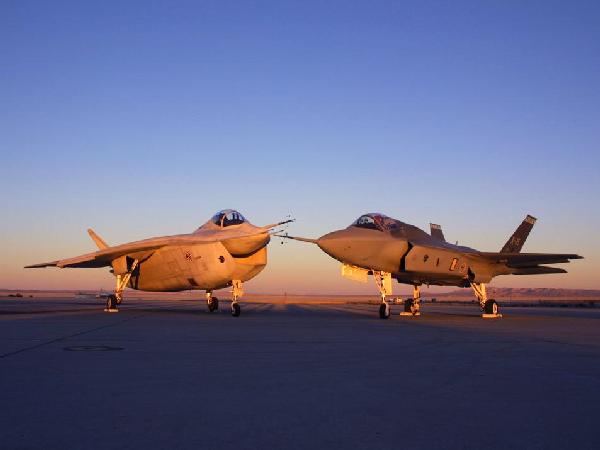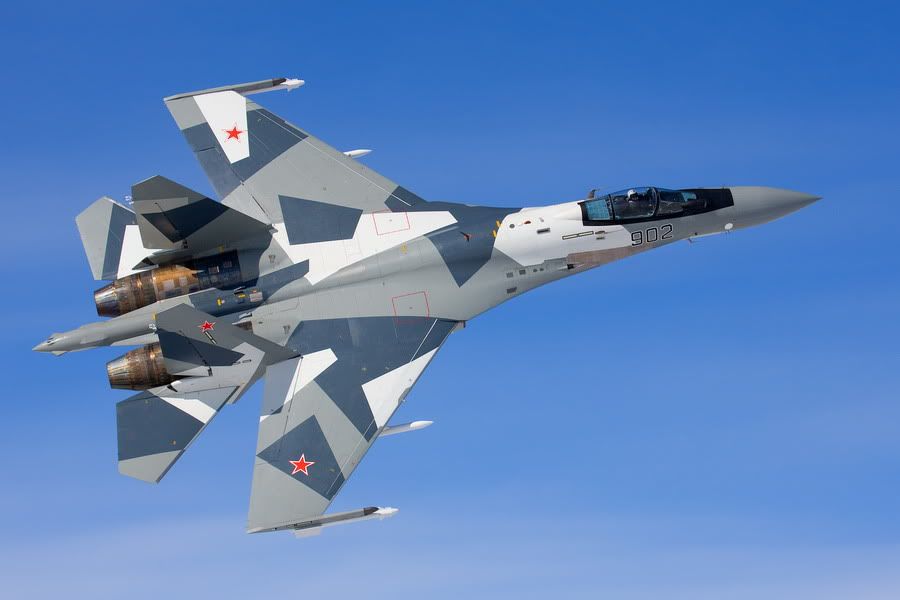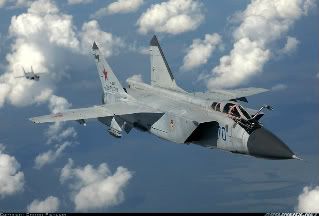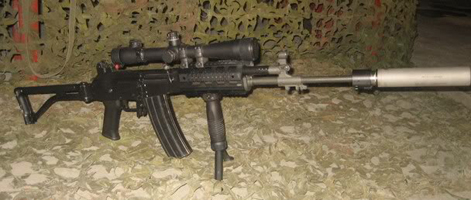F-35 News
Moderadores: Glauber Prestes, Conselho de Moderação
- cabeça de martelo
- Sênior

- Mensagens: 40538
- Registrado em: Sex Out 21, 2005 10:45 am
- Localização: Portugal
- Agradeceu: 1204 vezes
- Agradeceram: 3024 vezes
Re: F-35 News
O T-50 fez até agora 2 voos, as várias versões do F-35 já voam à anos. Queres comparar?
- Luís Henrique
- Sênior

- Mensagens: 8391
- Registrado em: Sex Mai 07, 2004 12:25 pm
- Agradeceu: 1 vez
- Agradeceram: 184 vezes
Re: F-35 News
O F-35 é um bomb truck de médio porte.cabeça de martelo escreveu:O T-50 fez até agora 2 voos, as várias versões do F-35 já voam à anos. Queres comparar?
O Pac Fa é um caça de superioridade aérea de grande porte.
Queres comparar?
Su-35BM - 4ª++ Geração.
Simplesmente um GRANDE caça.
Simplesmente um GRANDE caça.
- soultrain
- Sênior

- Mensagens: 12154
- Registrado em: Dom Jun 19, 2005 7:39 pm
- Localização: Almada- Portugal
Re: F-35 News
F-35 Delayed Again
Here’s a surprise, the F-35 Joint Strike Fighter, the common operating platform for the Air Force, Navy, Marines, along with a host of foreign nations, has run headlong into further delays, stretching out the development time and adding costs to what is already the Pentagon’s most expensive program.
According to the most recent Pentagon plans, the military was to buy 2,456 F-35s for the Air Force, Navy and Marines at a cost of about $246 billion. The idea was to get some synergy going between the services on the new somewhat stealthy aircraft and achieve economies of scale to keep the price down on the aircraft. That last goal hasn’t worked out so well.
Since 2002, the F-35 program’s costs have risen by nearly $100 billion. Cost inflation is driven by delays in development, its now two years late, and some weight issues with the Marine vertical take off and landing version. According to the ever helpful analysts at the Congressional Research Service, best case scenario is the price tag for an F-35 now sits somewhere between $80 to $100 billion. Expect that price to go nowhere but up, especially now that another year’s delay has been added.
From Defense News John Reed:
“The Pentagon’s No. 2 official said this week that the jet’s development schedule would slip between 12 months and 13 months despite an aggressive restructuring of the program that was announced earlier this month.
“The development was originally projected to last an additional 30 months; we think with the additional test aircraft it will be closer to a delay of about 12 or 13 months, but I can’t give you the cost numbers,” The Australian newspaper quoted [Deputy Defense Secretary Bill] Lynn as saying during a speech at a shipyard in South Australia. He did not say if this would affect the delivery timeline for the JSF.
Under the Pentagon’s restructuring that was announced Feb. 1, Defense Secretary Robert Gates ordered an additional test jet and $2.8 billion be put into the extended F-35 SDD, withheld more than $600 million in performance fees from Lockheed, cut planes from F-35 acquisition coffers and fired Marine Corps Maj. Gen. David Heinz, the Pentagon’s F-35 program manager.
The Defense Department is requesting $10.7 billion in its 2011 budget to continue development on the F-??35 and purchase 43 of the planes.”
The Marines are supposed to begin taking delivery of their first batch of F35Bs in 2012. That’s probably not going to happen. I hope they have a good backup plan.
- Greg
February 18th, 2010
Here’s a surprise, the F-35 Joint Strike Fighter, the common operating platform for the Air Force, Navy, Marines, along with a host of foreign nations, has run headlong into further delays, stretching out the development time and adding costs to what is already the Pentagon’s most expensive program.
According to the most recent Pentagon plans, the military was to buy 2,456 F-35s for the Air Force, Navy and Marines at a cost of about $246 billion. The idea was to get some synergy going between the services on the new somewhat stealthy aircraft and achieve economies of scale to keep the price down on the aircraft. That last goal hasn’t worked out so well.
Since 2002, the F-35 program’s costs have risen by nearly $100 billion. Cost inflation is driven by delays in development, its now two years late, and some weight issues with the Marine vertical take off and landing version. According to the ever helpful analysts at the Congressional Research Service, best case scenario is the price tag for an F-35 now sits somewhere between $80 to $100 billion. Expect that price to go nowhere but up, especially now that another year’s delay has been added.
From Defense News John Reed:
“The Pentagon’s No. 2 official said this week that the jet’s development schedule would slip between 12 months and 13 months despite an aggressive restructuring of the program that was announced earlier this month.
“The development was originally projected to last an additional 30 months; we think with the additional test aircraft it will be closer to a delay of about 12 or 13 months, but I can’t give you the cost numbers,” The Australian newspaper quoted [Deputy Defense Secretary Bill] Lynn as saying during a speech at a shipyard in South Australia. He did not say if this would affect the delivery timeline for the JSF.
Under the Pentagon’s restructuring that was announced Feb. 1, Defense Secretary Robert Gates ordered an additional test jet and $2.8 billion be put into the extended F-35 SDD, withheld more than $600 million in performance fees from Lockheed, cut planes from F-35 acquisition coffers and fired Marine Corps Maj. Gen. David Heinz, the Pentagon’s F-35 program manager.
The Defense Department is requesting $10.7 billion in its 2011 budget to continue development on the F-??35 and purchase 43 of the planes.”
The Marines are supposed to begin taking delivery of their first batch of F35Bs in 2012. That’s probably not going to happen. I hope they have a good backup plan.
- Greg
February 18th, 2010
"O que se percebe hoje é que os idiotas perderam a modéstia. E nós temos de ter tolerância e compreensão também com os idiotas, que são exatamente aqueles que escrevem para o esquecimento"
NJ
- soultrain
- Sênior

- Mensagens: 12154
- Registrado em: Dom Jun 19, 2005 7:39 pm
- Localização: Almada- Portugal
Re: F-35 News
Nesta altura, ainda não terem custo fixo por aeronave, nem eu esperava. E querem vocês que o NG tenha tudo certinho...
"O que se percebe hoje é que os idiotas perderam a modéstia. E nós temos de ter tolerância e compreensão também com os idiotas, que são exatamente aqueles que escrevem para o esquecimento"
NJ
-
PRick
Re: F-35 News
Bem, eles tinham igual ao Gripen NG, a tal estimativa.soultrain escreveu:Nesta altura, ainda não terem custo fixo por aeronave, nem eu esperava. E querem vocês que o NG tenha tudo certinho...
[]´s
- Penguin
- Sênior

- Mensagens: 18983
- Registrado em: Seg Mai 19, 2003 10:07 pm
- Agradeceu: 5 vezes
- Agradeceram: 374 vezes
Re: F-35 News
Ares Blog
JSF: International Procurement Plans
Posted by Robert Wall at 2/22/2010 4:01 AM CST
In answers to parliament largely spelling out the Dutch preference for retaining the GE/Rolls-Royce F136 alternative engine program, the Dutch defense ministry has also disclosed production plans for the core participating countries through 2034 (expected FMS customers, such as Israel and Singapore, are absent).
The table is largely based on estimates and if the past few weeks have demonstrated one thing, it is that even if this were a concrete plan, reality would look very different.
However, the update provides an insight into what some of the countries are thinking. Particularly curious is the UK production profile:

JSF: International Procurement Plans
Posted by Robert Wall at 2/22/2010 4:01 AM CST
In answers to parliament largely spelling out the Dutch preference for retaining the GE/Rolls-Royce F136 alternative engine program, the Dutch defense ministry has also disclosed production plans for the core participating countries through 2034 (expected FMS customers, such as Israel and Singapore, are absent).
The table is largely based on estimates and if the past few weeks have demonstrated one thing, it is that even if this were a concrete plan, reality would look very different.
However, the update provides an insight into what some of the countries are thinking. Particularly curious is the UK production profile:

Sempre e inevitavelmente, cada um de nós subestima o número de indivíduos estúpidos que circulam pelo mundo.
Carlo M. Cipolla
Carlo M. Cipolla
- Sterrius
- Sênior

- Mensagens: 5140
- Registrado em: Sex Ago 01, 2008 1:28 pm
- Agradeceu: 115 vezes
- Agradeceram: 323 vezes
Re: F-35 News
sinceramente eu nao consigo nenhum país da tabela conseguir manter F35 nos numeros "sonhados".
Eu prevejo cortes de +- 50% nos numeros dos paises participantes.
Eu prevejo cortes de +- 50% nos numeros dos paises participantes.
- P44
- Sênior

- Mensagens: 55668
- Registrado em: Ter Dez 07, 2004 6:34 am
- Localização: O raio que vos parta
- Agradeceu: 2877 vezes
- Agradeceram: 2539 vezes
Re: F-35 News
http://www.theaustralian.com.au/politic ... 5834053074Scientists warned defence department against Joint Strike Fighter
* Cameron Stewart
* From: The Australian
* February 25, 2010 12:00AM
AN internal Defence study warned that the new Joint Strike Fighter would be a high-risk venture for Australia, admitting that the plane had weaknesses, including poor engine thrust that made it difficult to dodge missiles.
The blunt criticisms of the warplane contained in the study by Defence scientists in 2000 have never been aired publicly by the government.
But the Defence Science and Technology Organisation study, obtained by The Australian, was far more critical of the other fighter jet options available to Australia if it did not choose the JSF.
The document uses highly undiplomatic language to trash the performance of the warplanes used by Australia's closest allies.
The DSTO study, described as a "first-cut analysis" of Australia's future fighter needs, was written two years before the Howard government signed up to the US-led JSF program in 2002, abandoning the tender process and stunning aircraft manufacturers.
Start of sidebar. Skip to end of sidebar.
End of sidebar. Return to start of sidebar.
Titled "A Preliminary Assessment of Inhabited Platforms for AIR6000" and written by the DSTO's Graeme Murray and David Carr, the study is significant because it is one of only a handful of studies that looked at alternatives to the JSF.
The government plans to buy 100 JSFs for $16 billion in what will be the largest Australian defence purchase in history.
The DSTO report, written at a time when the JSF existed only on paper, said that if Australia signed on to the JSF program, it would be doing so without knowing the plane's final capability and costs.
"JSF has present serious shortfalls in engine performance and incomplete sensor-fusion capability," the DSTO said.
"The aircraft lacks engine thrust in the baseline configuration due to the high weight, affecting the use of manoeuvrability to defeat missile attack."
It also warned of hi-tech risks in the program because of tight schedule and cost targets, but it gave the plane strong marks for its stealth, range, payload and its "all weather, 24-hour lethality".
It said the JSF would not be cheaper to acquire than other fighters, but would be cheaper to maintain and service.
The study favours the JSF over other options and is blunt about the shortcomings of Australia's other fighter options. It describes the US F-16 used by the US Air Force as having a weak airframe and poor stealth.
"Old airframe lacks agility to outmanoeuvre missiles and has a small internal fuel capacity," the DSTO said of the F-16.
It said Europe's Typhoon fighter had limited strike capability and was unreliable.
"Present (strike) capability is lacking due to limited sensors and weapons carrying capability," it said of the Typhoon.
"Low reliability will mean high costs to operate."
It said Sweden's Gripen fighter had poor stealth, an underdeveloped electronic warfare system and payload and range limitations.
The DSTO found that the earlier version of the F/A-18E Super Hornet -- not the Block II version that has since been purchased by Australia -- was underpowered, lacked endurance and "risks being shot from behind with a radar-guided missile".
The US F-15E lacked stealth while France's Rafale had an unreliable and weak engine.
"The F-15E is good now, but not likely to be defensible in the expected electronic warfare environment in the 2010 timeframe," the DSTO said. "Rafale has short-term shortfalls in engine and radar performance."
The DSTO said the F-22 fighter -- the production of which was recently cancelled by US Defence Secretary Robert Gates -- had limited strike capability and was very expensive.
Despite these criticisms, the study recommended narrowing Australia's choice of a new fighter jet to only three: the JSF, the American F-15E and the French Rafale.
*Turn on the news and eat their lies*
- Carlos Lima
- Sênior

- Mensagens: 18932
- Registrado em: Qui Mai 12, 2005 6:58 am
- Agradeceu: 1275 vezes
- Agradeceram: 631 vezes
- Penguin
- Sênior

- Mensagens: 18983
- Registrado em: Seg Mai 19, 2003 10:07 pm
- Agradeceu: 5 vezes
- Agradeceram: 374 vezes
Re: F-35 News
Desencavador MOR do CPLP!P44 escreveu:http://www.theaustralian.com.au/politic ... 5834053074Scientists warned defence department against Joint Strike Fighter
* Cameron Stewart
* From: The Australian
* February 25, 2010 12:00AM
AN internal Defence study warned that the new Joint Strike Fighter would be a high-risk venture for Australia, admitting that the plane had weaknesses, including poor engine thrust that made it difficult to dodge missiles.
The blunt criticisms of the warplane contained in the study by Defence scientists in 2000 have never been aired publicly by the government.
But the Defence Science and Technology Organisation study, obtained by The Australian, was far more critical of the other fighter jet options available to Australia if it did not choose the JSF.
The document uses highly undiplomatic language to trash the performance of the warplanes used by Australia's closest allies.
The DSTO study, described as a "first-cut analysis" of Australia's future fighter needs, was written two years before the Howard government signed up to the US-led JSF program in 2002, abandoning the tender process and stunning aircraft manufacturers.
Start of sidebar. Skip to end of sidebar.
End of sidebar. Return to start of sidebar.
Titled "A Preliminary Assessment of Inhabited Platforms for AIR6000" and written by the DSTO's Graeme Murray and David Carr, the study is significant because it is one of only a handful of studies that looked at alternatives to the JSF.
The government plans to buy 100 JSFs for $16 billion in what will be the largest Australian defence purchase in history.
The DSTO report, written at a time when the JSF existed only on paper, said that if Australia signed on to the JSF program, it would be doing so without knowing the plane's final capability and costs.
"JSF has present serious shortfalls in engine performance and incomplete sensor-fusion capability," the DSTO said.
"The aircraft lacks engine thrust in the baseline configuration due to the high weight, affecting the use of manoeuvrability to defeat missile attack."
It also warned of hi-tech risks in the program because of tight schedule and cost targets, but it gave the plane strong marks for its stealth, range, payload and its "all weather, 24-hour lethality".
It said the JSF would not be cheaper to acquire than other fighters, but would be cheaper to maintain and service.
The study favours the JSF over other options and is blunt about the shortcomings of Australia's other fighter options. It describes the US F-16 used by the US Air Force as having a weak airframe and poor stealth.
"Old airframe lacks agility to outmanoeuvre missiles and has a small internal fuel capacity," the DSTO said of the F-16.
It said Europe's Typhoon fighter had limited strike capability and was unreliable.
"Present (strike) capability is lacking due to limited sensors and weapons carrying capability," it said of the Typhoon.
"Low reliability will mean high costs to operate."
It said Sweden's Gripen fighter had poor stealth, an underdeveloped electronic warfare system and payload and range limitations.
The DSTO found that the earlier version of the F/A-18E Super Hornet -- not the Block II version that has since been purchased by Australia -- was underpowered, lacked endurance and "risks being shot from behind with a radar-guided missile".
The US F-15E lacked stealth while France's Rafale had an unreliable and weak engine.
"The F-15E is good now, but not likely to be defensible in the expected electronic warfare environment in the 2010 timeframe," the DSTO said. "Rafale has short-term shortfalls in engine and radar performance."
The DSTO said the F-22 fighter -- the production of which was recently cancelled by US Defence Secretary Robert Gates -- had limited strike capability and was very expensive.
Despite these criticisms, the study recommended narrowing Australia's choice of a new fighter jet to only three: the JSF, the American F-15E and the French Rafale.
Esse estudo é de 2000! Em 2000 ainda não se sabia quem venceria o JSF, se os demonstradores de tecnologia Boeing X-32 ou o LM X-35! Como esses iluminados puderam sair com pérolas do tipo...
"JSF has present serious shortfalls in engine performance and incomplete sensor-fusion capability," the DSTO said.

[]s
Sempre e inevitavelmente, cada um de nós subestima o número de indivíduos estúpidos que circulam pelo mundo.
Carlo M. Cipolla
Carlo M. Cipolla
- P44
- Sênior

- Mensagens: 55668
- Registrado em: Ter Dez 07, 2004 6:34 am
- Localização: O raio que vos parta
- Agradeceu: 2877 vezes
- Agradeceram: 2539 vezes
Re: F-35 News
Pentagon Reports Document Continuing Lockheed-Martin Failures (excerpt)
(Source: Center for Defense Information; issued Feb. 24, 2010)

The F-35 Joint Strike Fighter is facing even more delays and problems than have been made public, according to reports by the Defense Contract Management Agency. (Lockheed Marttin photo)
Under the Freedom of Information Act (FOIA), the CDI Straus Military Reform Project has obtained almost two years of monthly reports from the Defense Contract Management Agency (DCMA) on Lockheed Martin’s production of the F-35 Joint Strike Fighter.
The documents do not paint a pretty picture, explains Straus Military Reform Project Director Winslow Wheeler.
The Defense Contract Management Agency’s (DCMA) most recent reports cover the months July through November 2009. The full reports are available below.
Their major points, as summarized by Winslow Wheeler, are as follows:
-- The F-35 assembly line at Forth Worth, Texas is being cannibalized for parts to support flight testing. This may be the first time an assembly line has been cannibalized for parts. See the summary of the August report below.
-- The continuing and sometimes deteriorating nature of the delays at Lockheed-Martin’s (L-M) Fort Worth plant refutes the L-M contention that things are getting better, and that the F-35 program learned from the past and with new design techniques is avoiding the kinds of problems experienced by “legacy” aircraft programs.
-- The cause, nature and implications of the “stand-down” mentioned in the November report could well be important, but are unreported by the press and are a matter looking for explanation. (end of excerpt)
Click here for the full article (with links to DCMA reports) on the CDI website.
http://www.cdi.org/program/document.cfm ... /index.cfm
-ends-
(Source: Center for Defense Information; issued Feb. 24, 2010)

The F-35 Joint Strike Fighter is facing even more delays and problems than have been made public, according to reports by the Defense Contract Management Agency. (Lockheed Marttin photo)
Under the Freedom of Information Act (FOIA), the CDI Straus Military Reform Project has obtained almost two years of monthly reports from the Defense Contract Management Agency (DCMA) on Lockheed Martin’s production of the F-35 Joint Strike Fighter.
The documents do not paint a pretty picture, explains Straus Military Reform Project Director Winslow Wheeler.
The Defense Contract Management Agency’s (DCMA) most recent reports cover the months July through November 2009. The full reports are available below.
Their major points, as summarized by Winslow Wheeler, are as follows:
-- The F-35 assembly line at Forth Worth, Texas is being cannibalized for parts to support flight testing. This may be the first time an assembly line has been cannibalized for parts. See the summary of the August report below.
-- The continuing and sometimes deteriorating nature of the delays at Lockheed-Martin’s (L-M) Fort Worth plant refutes the L-M contention that things are getting better, and that the F-35 program learned from the past and with new design techniques is avoiding the kinds of problems experienced by “legacy” aircraft programs.
-- The cause, nature and implications of the “stand-down” mentioned in the November report could well be important, but are unreported by the press and are a matter looking for explanation. (end of excerpt)
Click here for the full article (with links to DCMA reports) on the CDI website.
http://www.cdi.org/program/document.cfm ... /index.cfm
-ends-
*Turn on the news and eat their lies*
Re: F-35 News
UPDATE 1-Pentagon slips F-35 schedule, reviews costs
Tue Mar 2, 2010 11:22am EST
By Andrea Shalal-Esa
WASHINGTON, March 2 - U.S. Air Force Secretary Michael Donley on Tuesday underscored the Pentagon's commitment to the Lockheed Martin Corp (LMT.N) F-35 fighter program and said the program would likely survive a mandatory live-or-die review triggered by cost overruns on the program.
Pentagon acquisition chief Ashton Carter last week signed an acquisition decision memorandum implementing restructuring steps outlined by top defense officials in recent weeks.
In the Feb. 24 memo, which was first reported by the DODBuzz.com website, Carter said the Pentagon was extending the development phase of the program by 13 months; adding one carrier variant plane for extra testing; and moving a decision about moving into full-rate production to November 2015, when initial operational testing is completed.
Donley told defense reporters the Pentagon was still working through details before notifying Congress about a probable breach of the Nunn-McCurdy cost thresholds that would trigger a review that could lead to the program's cancellation.
But said no "showstoppers" had emerged that could lead to a decision to cancel the program.
There also were no alternatives in the Pentagon's weapons arsenal, he added.
In Carter's memo, he agreed to add $2.8 billion to the development cost of the F-35, and said the Pentagon would withhold $614 million in award fees from Lockheed and the other contractors on the program, Northrop Grumman Corp (NOC.N) and BAE Systems (BAES.L).
Donley said the Pentagon was restructuring its contract with Lockheed to encourage the company to make good its earlier promises on the program and meet the schedule.
He said it was unclear how many additional jets could be purchased of the 122 that were removed from the Pentagon's five-year budget plan.
Carter's memo said the department would request long lead procurement funding for 48 fighter planes in fiscal 2011.
Donley said moves by Lockheed to lower costs on the program would allow the department to buy more aircraft than planned in the fiscal 2011 budget plan, and could allow the military to re-accelerate the now-delayed timetable for moving into full-rate production and operational use of the new planes.
Donley also said he was not aware of any further management changes in the F-35 program "on the government side" after a decision last month to remove Marine Corps Major General David Heinz, who was running the program. He said it was unclear when a replacement for Heinz would be named, but said Senate confirmation was needed since it would now be a three-star position.
Carter and the chief executives of the prime contractors working on the F-35 programs are due to meet at the Lockheed plant in Fort Worth, Texas, later this week.
Donley said the Air Force was considering funding a service life extension program for the Lockheed F-16 fighter planes, given the expected delays in fielding of the F-35, but said not final decisions had been made.
It was not yet clear if any funding for such a program would be added to the fiscal 2011 budget or later budget years, he said. (Reporting by Andrea Shalal-Esa)
Reuters
- Sterrius
- Sênior

- Mensagens: 5140
- Registrado em: Sex Ago 01, 2008 1:28 pm
- Agradeceu: 115 vezes
- Agradeceram: 323 vezes
Re: F-35 News
Oficial.
JSF adiado até 2015. (2 anos de adiamento).
Ultrapassou o orçamento e agora devem ser apresentadas alternativas ao F35 em até 60dias. (Ou ideias para fazer o F35 decolar).
Ao menos resumidamente é isso! Vejamos agora o que os EUA vai fazer pra resolver a situação.
JSF adiado até 2015. (2 anos de adiamento).
Ultrapassou o orçamento e agora devem ser apresentadas alternativas ao F35 em até 60dias. (Ou ideias para fazer o F35 decolar).
Ao menos resumidamente é isso! Vejamos agora o que os EUA vai fazer pra resolver a situação.




.jpg)



